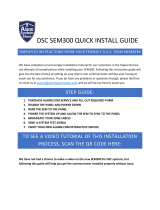
Copyright © 2012 Alarm.com | www.alarm.com | v3.0
Concord 4 CDMA Module | Installation Guide
No Home ID
present (lasts
until the module
connects to
Alarm.com and is
configured)
When the CDMA module first connects
to Alarm.com it is configured with a
necessary unique network ID.
Module States (modes)
There are three module states (modes).
Idle
In Idle mode, the AC power is up, the battery level is greater than 11.5
volts, and the module is not currently connected to the Alarm.com
servers. This is normal for the module and the most common state.
L1 - Flashes errors, if any.
L2 - Communication with panel
L3 - Communication with radio unit
L4 - Signal level (0 to 5 bars)
L5 – Flashes errors, if any
PowerSave mode
In PowerSave mode, the module just powered up, AC power is down, or
battery level is less than 11.5 volts. The radio part of the module draws
10 mA in PowerSave mode. It is fully functional and will go into
Connected mode as soon as a signal needs to be sent. Performing a
manual phone test will switch the module into Idle mode and update the
signal level reading.
L1 - Inactive
L2 - Communication with panel
L3 - Same flashing pattern as L2
L4 - Inactive
L5 – Inactive
Connected mode
In Connected mode, the module is connected to the Alarm.com servers
and reported an alarm or other condition. The module stays in
Connected mode for at least six minutes after the last message is
exchanged. Entering Installer Programming mode will cause the module
to go into Idle mode.
L1 - Flashes errors, if any
L2 - Communication with panel
L3 - Communication with Alarm.com
L4 - Alternates two seconds on, then two seconds off
L5 - Inactive
Troubleshooting/Testing
Tips
• Check CDMA status LED L1 to see if it is flashing any errors. See
Table 5 on page 4 for descriptions of the errors indicated.
• If the power LEDs (the green LED at the top of the module in
Figure 1 on page 1) is not on, turn off the panel power and verify
that all wiring is correct.
• If the Module status LEDs (on the left side of the module in
Figure 1 on page 1) do not turn on immediately after initial power
up, be sure you have given enough time for the module to initiate
communication with Alarm.com. You must wait 5 to 8 minutes
after power up for the module to communicate with Alarm.com.
Verify that the “Access Code Lock” feature (in panel memory) is
turned off. “Access Code Lock” MUST be turned off for correct
operation.
Sensors 94, 95, 96
If sensors 94, 95, and 96 are not learned in, after doing a manual
phone test, the text for these sensors will display important
information for troubleshooting purposes. Alarm.com Technical
Support staff may request this information during service calls.
• Sensor 94 text: IMSI number.
• Sensor 95 text: Type of central station reports enabled.
See Table 7 for a reference of the codes displayed.
• Sensor 96 text: Module serial number.
Table 7: Central Station Reporting Bits
Phone failure (phone failure will always be reported for alarms and cancels)
Specifications
Concord panels w
i
th
s
o
f
t
w
a
r
e
versions
4
.
0
and
h
i
gher
12 V nominal, 65 mA (continuous) 1600 mA
(instantaneous peaks) maximum (from panel or auxiliary
power supply)
One 4-wire SuperBus 2000 auto addressing power
communication data bus
One module/panel communication status LED, one
module power LED, one automation LED, three wireless
communication status LEDs
-30 to 140°F (-34 to 60°C)
90% relative humidity non-condensing
FCC part 15, Verizon Certified
Regulatory Information
Changes or modifications not expressly approved by Alarm.com can void the user’s authority
to operate the equipment.
This equipment has been tested and found to comply with the limits for a Class B digital
device, pursuant to part 15 of the FCC Rules. These limits are designed to provide reasonable
protection against harmful interference in a residential installation. This equipment
generates, uses, and can radiate radio frequency energy and, if not installed and used in
accordance with the instructions, may cause harmful interference to radio communications.
However, there is no guarantee that interference will not occur in a particular installation. If
this equipment does cause harmful interference to radio or television reception, which can be
determined by turning the equipment off and on, the user is encouraged to try to correct the
interference by one or more of the following measures:
Reorient or relocate the receiving antenna.
Increase the separation between the equipment and receiver.
Connect the equipment into an outlet on a circuit different form that which the
receiver is connected
Consult the dealer or an experienced radio/TV technician for help.
Operation is subject to the following two conditions:
(1) This device may not cause interference
(2) This device must accept any interference, including interference that may cause undesired
operation of the device
This equipment complies with the FCC RF radiation exposure limits set forth for an
uncontrolled environment. This equipment should be installed and operated with a minimum
distance of 20 centimeters between the radiator and your body.
FCC IDs: YL6-143200H5V4
This device contains FCC ID: RI7CE910-DUAL, IC: 5131A-CE910-DUAL






